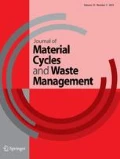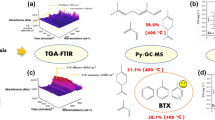Abstract
Vacuum pyrolysis of polymeric wastes containing hazardous cyano groups was studied using low temperature pyrolysis mass spectrometry. Specifically, the study analyzed the presence of toxic compounds among the pyrolysis products. The polymers were pyrolyzed directly in the solid probe of a quadruple mass spectrometer within an ion source at a pressure of 10−6 Torr and then sorted by quadrupole mass analyzer. Polyethyl cyanoacrylate degrades by depolymerization, mostly into the ethyl cyanoacrylate monomer units. The degradation of polyurethane produces nonpolymeric urethane, isocyanates, amines and ethers. Polyacrylonitrile degrades via a depolymerization pathway into oligonitriles, acrylonitrile, ammonia and hydrogen cyanide.






Similar content being viewed by others
References
Pinto F, Costa P, Gulyurtlu I, Cabrita I (1999) Pyrolysis of plastic wastes. 1. Effect of plastic waste composition on product yield. J Anal Appl Pyrolysis 51:39–55
Greena A, Sadrameli S (2004) Analytical representations of experimental polyethylene pyrolysis yields. J Anal Appl Pyrolysis 72:329–335
Miskolczi N, Bartha L, Bartha L, Deak G, Jover B (2004) Thermal degradation of municipal plastic waste for production of fuel-like hydrocarbons. Polym Degrad Stab 86:357–366
Miskolczia N, Barthaa L, Deaka G, Joverb B, Kallo D (2004) Thermal and thermo-catalytic degradation of high-density polyethylene waste. J Anal Appl Pyrolysis 72:235–242
Demirbas A (2004) Pyrolysis of municipal plastic wastes for recovery of gasoline-range hydrocarbons. J Anal Appl Pyrolysis 72:97–102
Mastral J, Berrueco C, Ceamanos J (2007) Modelling of the pyrolysis of high density polyethylene: product distribution in a fluidized bed reactor. J Anal Appl Pyrolysis 79:313–322
Lee KH (2007) Pyrolysis of municipal plastic wastes separated by difference of specific gravity. J Anal Appl Pyrolysis 79:362–367
Miranda R, Pakdel H, Roc C, Vasile C (2001) Vacuum pyrolysis of commingled plastics containing PVC II. Product analysis. Polym Degrad Stab 73:47–67
Bhaskar T, Tanabe M, Muto A, Sakata Y, Liu C, Chen M, Chao C (2005) Analysis of chlorine distribution in the pyrolysis products of poly(vinylidene chloride) mixed with polyethylene, polypropylene. Polym Degrad Stab 89:38–42
Tang C, Wang Y, Zhou Q (2003) Catalytic effect of Al–Zn composite catalyst on the degradation of PVC-containing polymer mixtures into pyrolysis oil Zheng. Polym Degrad Stab 81:89–94
Montaudo G, Puglisi C, Samperi E (1993) Chemical reactions occurring in the thermal treatment of polymer blend investigated by direct pyrolysis mass spectrometry. J Polym Sci A Polym Chem 31:13
Wikipedia website. http://en.wikipedia.org/wiki/ (5 October 2011)
Toriumi M, Raslan F, Friedman M et al (1990) Histotoxicity of cyanoacrylate tissue adhesives. A comparative study. Arch Otolaryngol Head Neck Surg 116:546
Pawar R, Sarda S, Borade R, Jadhav A, Dakea S, Domb A (2008) Cyano Acrylate polymers in medical applications. Recent Patents Mater Sci 1:186–199
Bello D, Woskie S, Streicher R, Liu Y, Stowe M, Eisen E, Ellenbecker M, Sparer J, Youngs F, Cullen M, Redlich C (2004) Polyisocyanates in occupational environments: a critical review of exposure limits and metrics. Am J Ind Med 46:480–491
Wakefield J (2010) A toxicological review of the products of combustion. Health protection Agency CHAPD HQ
Blazso M, Varhegyi G, Jakab E (1980) Pyrolysis-gas chromatography of styrene–acrylonitrile copolymers: calculation of kinetic parameters and sequence distribution. J Anal Appl Pyrolysis 2:177–185
Surianaryanan M, Vijayaraghavan R, Raghavan V (1998) Spectroscopic investigations of polyacrylonitrile thermal degradation. J Polym Sci A Polym Chem 36:2503
Zoller L, Johnston V (1997) Composition and microstructure of acrylonitrile–butadiene copolymers by pyrolysis photoionization mass spectrometry. Anal Chem 69:3791
Wakefield J (2007) Acrylonitrile. Toxicological overview. Health Protection Agency, CHAPD HQ
Pritchard J. (2007) Hydrogen cyanide. Toxicological overview. Health Protection Agency, CHAPD HQ
Pritchard J (2007) Ammonia. Toxicological overview. Health Protection Agency, CHAPD HQ
Author information
Authors and Affiliations
Corresponding author
Rights and permissions
About this article
Cite this article
Badawy, S.M. Vacuum pyrolysis of polymeric wastes containing hazardous cyano groups. J Mater Cycles Waste Manag 15, 218–222 (2013). https://doi.org/10.1007/s10163-012-0113-6
Received:
Accepted:
Published:
Issue Date:
DOI: https://doi.org/10.1007/s10163-012-0113-6




